SAOCOM (SAR Observation & Communications Satellite)
EO
Atmosphere
Ocean
Multi-purpose imagery (ocean)
Satélite Argentino de Observación COn Microondas (SAOCOM), which translates to Argentine MicroWave Observation Satellite, is a constellation of two satellites, SAOCOM-1A and SAOCOM-1B, owned and operated by CONAE (Comision Nacional de Actividades Espaciales), the Argentinian Space Agency. The mission aims to provide effective Earth observation and disaster monitoring. SAOCOM-1A was launched in October 2018, SAOCOM-1B in August 2020, and their successors, SAOCOM-2A and -2B, are planned for launch in 2025 and 2026, respectively.
Quick facts
Overview
| Mission type | EO |
| Agency | ASI, CONAE |
| Mission status | Operational (nominal) |
| Launch date | 07 Oct 2018 |
| Measurement domain | Atmosphere, Ocean, Land, Snow & Ice |
| Measurement category | Multi-purpose imagery (ocean), Multi-purpose imagery (land), Vegetation, Landscape topography, Ocean topography/currents, Sea ice cover, edge and thickness, Soil moisture, Snow cover, edge and depth, Ocean surface winds, Atmospheric Winds, Ice sheet topography |
| Measurement detailed | Ocean imagery and water leaving spectral radiance, Land surface imagery, Vegetation type, Land cover, Ocean surface currents (vector), Land surface topography, Wind vector over sea surface (horizontal), Sea-ice cover, Snow cover, Soil moisture at the surface, Wind speed over sea surface (horizontal), Sea-ice thickness, Sea-ice type, Glacier motion, Sea-ice sheet topography, Glacier cover, Oil spill cover, Above Ground Biomass (AGB), Surface Coherent Change Detection, Vegetation Canopy (height), Vegetation Canopy (cover), Snow detection (mask) |
| Instruments | SAR-L |
| Instrument type | Imaging microwave radars |
| CEOS EO Handbook | See SAOCOM (SAR Observation & Communications Satellite) summary |
Related Resources

Summary
Mission Capabilities
SAOCOM-1A and -1B carry identical instrument payloads, consisting of a single sensor L-SAR (L-band Synthetic Aperture Radar), a high-resolution, multi-purpose radar imager. L-SAR imagery is applicable in agriculture, fishery, forestry, weather, hydrology, oceanography, emergencies, natural resources of land and sea, urban areas and cartography.
Performance Specifications
L-SAR utilises a side-looking scanning technique with an observing frequency of 1.275 GHz and a field of regard 320 km. It images in three modes of operation, Stripmap, TopSAR narrow and TopSAR wide, with varying parameters depending on the polarisation mode chosen: quad, single or dual polarisation. Stripmap imagery is captured with a swath width of 20 - 40 km and angle of incidence of 20° - 50°, and spatial resolution 10 m across all polariations. TopSAR narrow has a swath width of 100 - 150 km, angle of incidence of 20° - 45°, and spatial resolution of 30 - 50 m, while TopSAR wide has a swath width of 220 - 350 km, angle of incidence of 20° - 45°, and spatial resolution of 50 - 100 m.
SAOCOM-1A and -1B operate in sun-synchronous orbits of altitude 619.6 km, inclination 97.86°, and period 97.1 minutes, with -1B 180° out of phase of -1A.
Space and Hardware Components
SAOCOM-1A and -1B use identical buses, designed and constructed by INVAP (INVestigación APlicada ("applied research")), with an estimated wet mass of approximately 1600 kg, and a design life of five years. The bus design contains onboard mass memory of 256 Gbit, with TT&C (Telemetry, Tracking and Control) transmitted in S-band, and SAR sensor data transmitted in X-band, and a download rate of 310 Mbit/s. The design also includes the 10 m x 3.5 m (35 m2) SAR ActivePhase Array antenna, and a 15 m2 foldable solar array wing.
SAOCOM (SAR Observation & Communications Satellite) Constellation
Spacecraft Launch Mission Status Sensor Complement Ground Segment References
The SAOCOM (SAtélite Argentino de Observación COn Microondas) satellite series represents Argentina's approved polarimetric L-band SAR (Synthetic Aperture Radar) constellation of two spacecraft, a program defined, managed and operated by CONAE (Comisión Nacional de Actividades Espaciales), Argentina's Space Agency, Buenos Aires. The SAOCOM-1 mission is composed of two satellites (SAOCOM-1A and -1B) to be launched consecutively. The overall objective of is to provide an effective Earth observation and disaster monitoring capability. 1) 2) 3) 4)
The SAOCOM requirements call for a capability to provide timely information in support of natural and anthropogenic disaster management (such as regional flooding, volcanic eruptions, Earth quakes, land slides, forest fires, etc.), and to conduct monitoring services for agriculture, mining and ocean applications - including monitoring surveys of Antarctica (study of continental glacier evolution, global change indicators, etc.). The goal is to obtain data with high-quality radiometric and geometric accuracy (eg. natural resources identification, interferometry, glaciology), and to provide also high revisit frequencies (daily) in support of specific operational requirements.
International participation in the SAOCOM mission:
• As of 2000, SAOCOM is a joint project of CONAE and ASI (Agenzia Spaziale Italiana), the Space Agency of Italy. To this effect, an agreement called SIASGE (Sistema Italo Argentino de Satélites para la Gestión de Emergencias - Italian/Argentinian satellite system for emergency management) has been signed under which the satellites in the Argentine SAOCOM system will operate jointly with the Italian COSMO-SkyMed constellation in X-band to provide frequent information relevant for emergency management. This approach of a two SAOCOM and a four COSMO-SkyMed spacecraft configuration offers an effective means of a twice-daily coverage capability. By joining forces, both agencies will be able to generate SAR products in X-band and in L-band for their customers.
• Belgium takes also part in the SAOCOM project of CONAE by the joint development of a processor, a simulator and the necessary tools for processing the data from the polarimetric SAR instrument. 5)
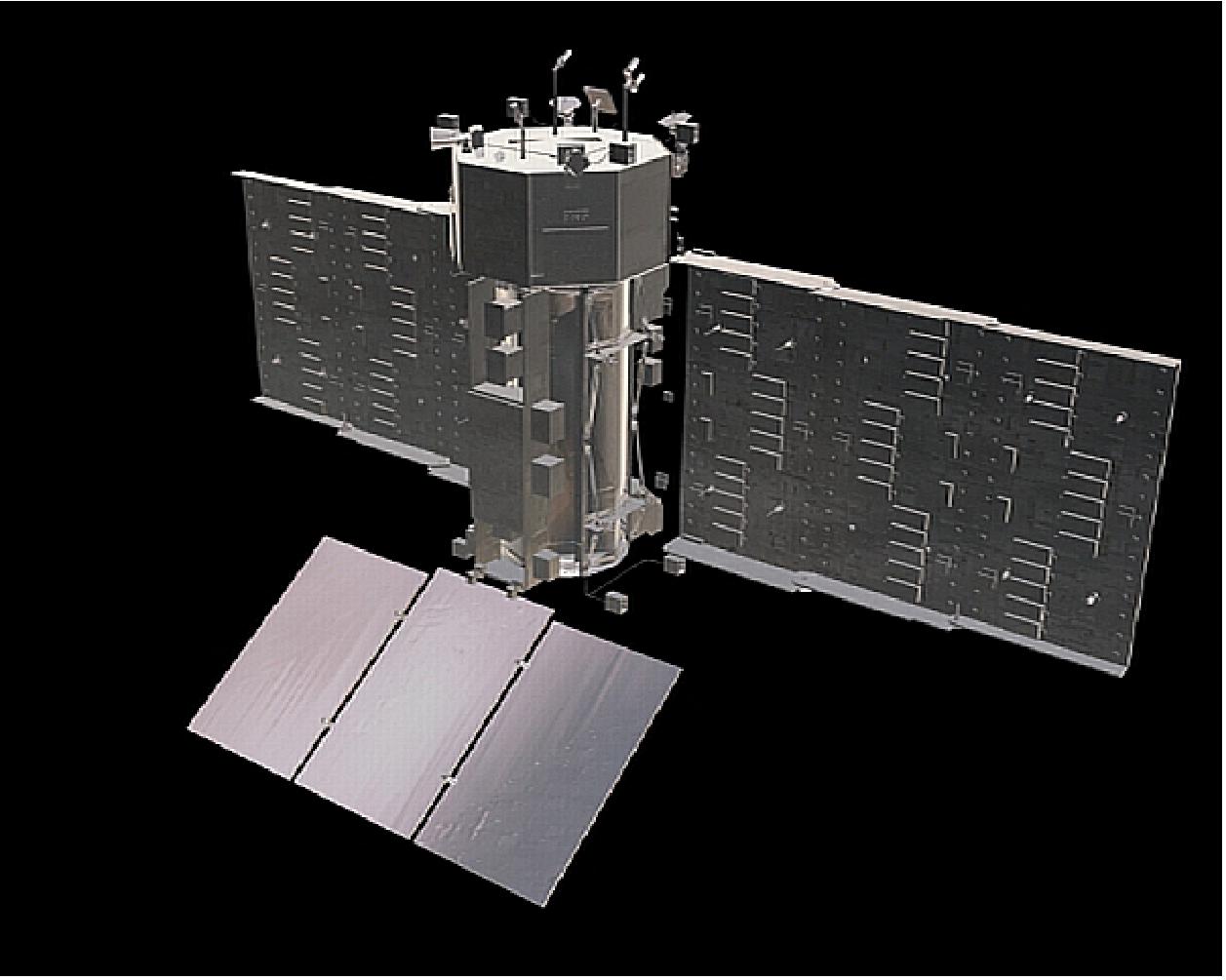
Spacecraft
INVAP (Rio Negro, Argentina) is the prime contractor for the design and construction of the SAOCOM-1 spacecraft and its SAR payload. The spacecraft platform is of SAC-C heritage. 6)
Each SAOCOM-1 spacecraft (SAOCOM-1A and SAOCOM-1B) has an estimated wet mass of ~1600 kg. The mission design life is 5 years.
Dimensions:
- h = 4.468 m, Ø=2.965 m stowed envelope
- 10 m x 3.5 m (35m2) SAR ActivePhase Array antenna
- 15 m2 foldable solar array wing.
RF communications: S-band for TT&C communications and X-band for SAR payload data download at a rate of 310 Mbit/s. An onboard mass memory of 256 Gbit is provided.
A spacecraft description will be provided when available.
Development Status
• August 1, 2018: SAOCOM 1A – the Argentinian Earth observation satellite – has shipped to Vandenberg Air Force Base ahead of launch aboard a SpaceX Falcon 9. The mission will be the first on the west coast to see a Falcon 9 first stage perform an RTLS (Return to Launch Site) recovery. 7)
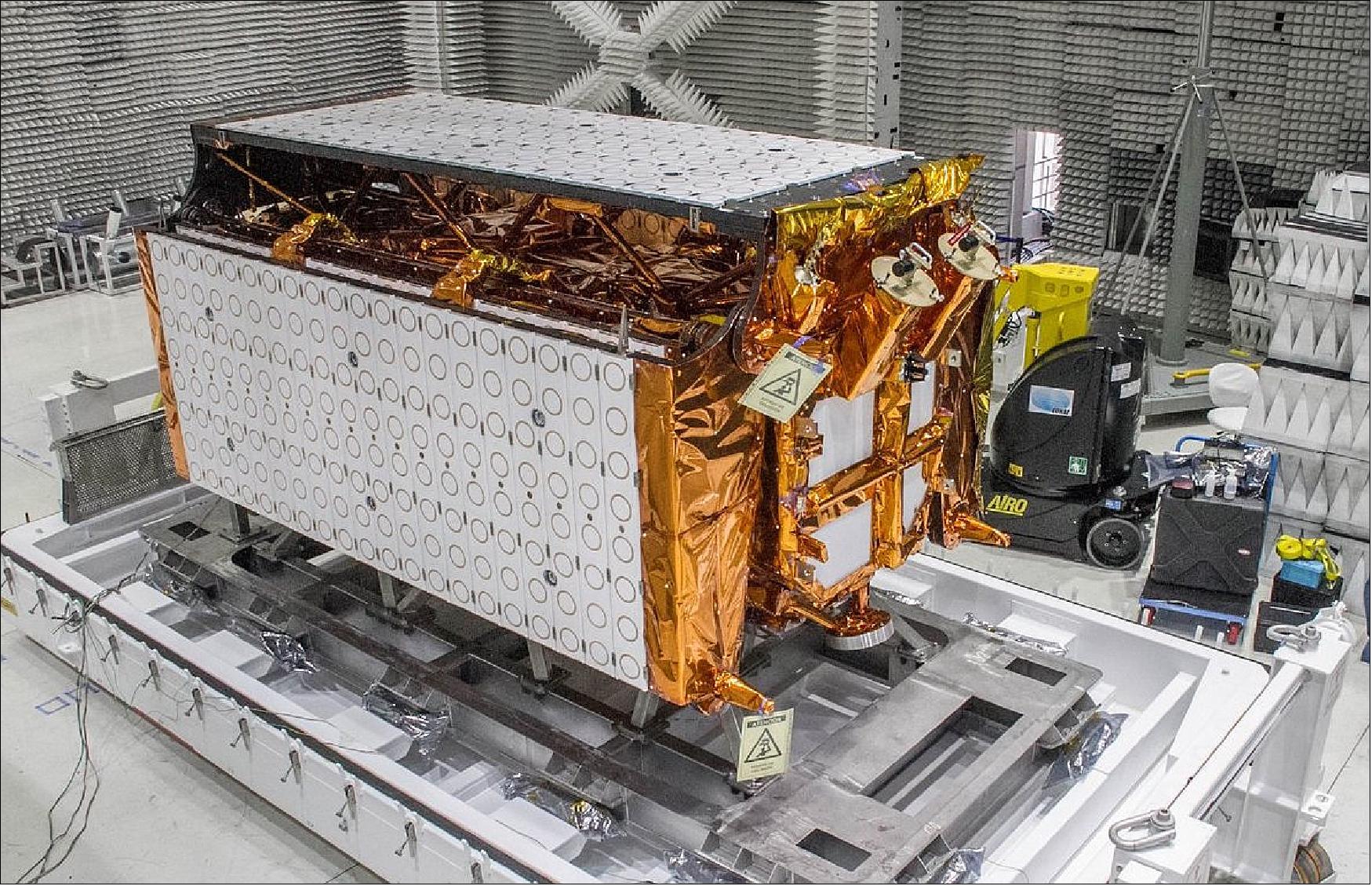
• July 29, 2018: Argentina is preparing for the launch of their first of four satellites to help monitor geological conditions and manage disasters, according to that nation's CONAE (National Space Activities Commission). 8)
- Argentina's SAOCOM-1A SAR satellite will be shipped later this month to Vandenberg Air Force Base in California for a launch that is scheduled for September. The satellite, designed and built by INVAP, will contribute to a number of tasks according to CONAE spokesperson Josefina Peres.
- With an expected operational life of 5.5 years, the satellite will orbit some 620 km above the Earth's surface and will collect data that is useful for agriculture, fishing, mining, geology, urban development and disaster management. And, according to Peres, the SAOCOM will be capable of capturing 500 images as it orbits 15 times a day. The satellite's mission, Peres said, will focus on two aspects: measuring soil humidity in the Argentine Pampas, or lowlands, as well as detecting and helping to manage natural and human disasters, such as floods, landslides, oil spills, fires, earthquakes and volcanic eruptions.
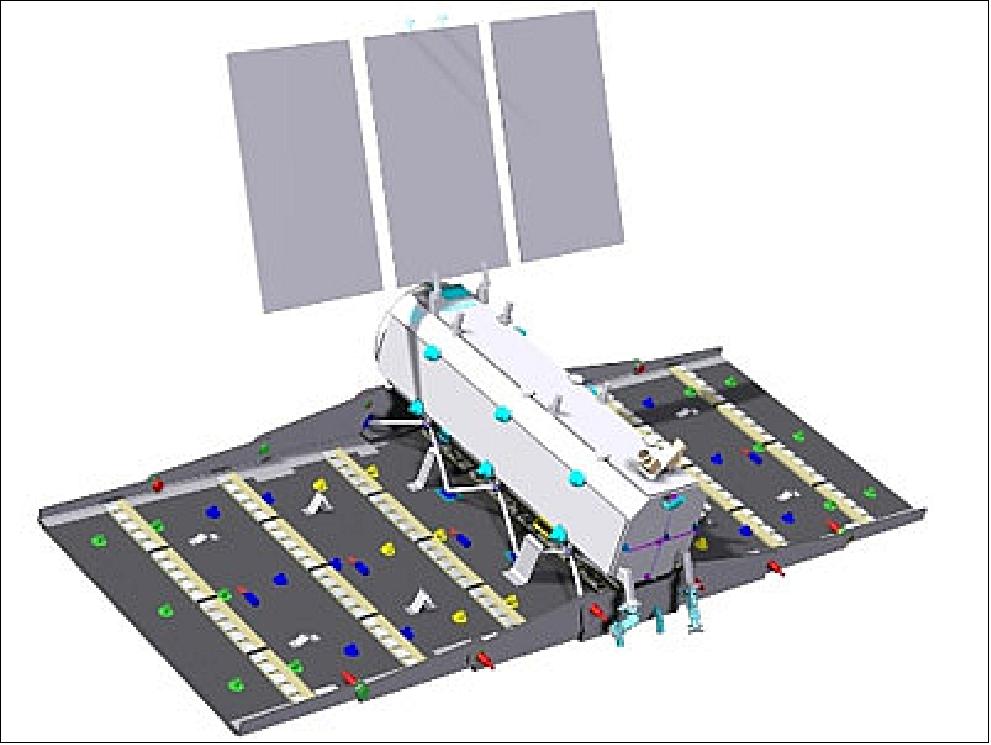
- Once on orbit, the satellite will mark CONAE's fifth space mission as it joins the country's two prior orbiting satellites — Arsat-1 and Arsat-2 — which were built by Argentine satellite maker ArSat and launched in 2014 and 2015, respectively.
- SAOCOM -1A features six computers that work in synchronicity; the spacecraft has a mass of 3,000 kg. Its antenna, designed in central Cordoba province, is composed of 140 smaller antennas. As many as 600 Argentine professionals have been working on the $500 million-satellite since 2011.
- SAOCOM 1-B is expected to be launched in 2019, followed by another two satellites as part of the SAOCOM 2 series, which will have the experiences collected from the first mission built in. Both INVAP and CONAE have ample experience in designing satellites and in space missions, as they developed the SAC-B, SAC-A, SAC-C and SAC-D Aquarius satellites.
• January 2, 2018: Professionals from CONAE (National Space Activities Commission), CNEA (National Commission of Atomic Energy), and the companies VENG, INVAP and CEATSA/Arsat concluded in Bariloche (Argentina) the electrical verifications and the mechanical assembly of the SAOCOM-1A, the new Argentine observation satellite developed by the CONAE together with other national organizations and companies. 9)
- The "body" of the satellite (the service platform) and its "eyes" (the radar antenna), with which it will observe the earth, are in communication. All the interfaces are correctly connected, in good condition and safe.
- After the electrical integration was completed and the communication of the platform with each of the seven panels of the radar antenna was verified, the mechanical assembly of the SAOCOM-1A satellite was concluded. This week, the deployment of the SAR antenna will be tested for the first time, entering the final testing stage of the satellite.
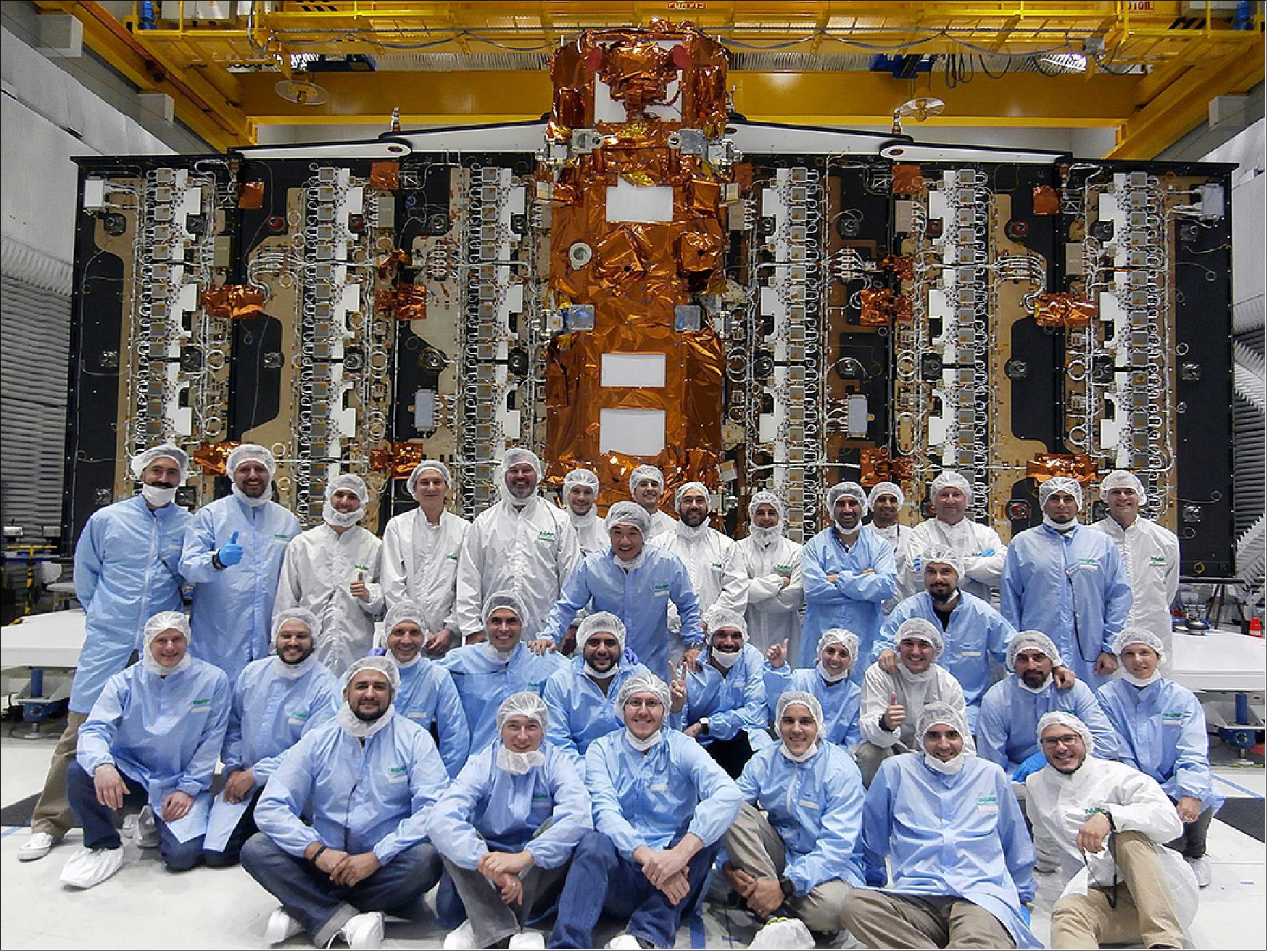
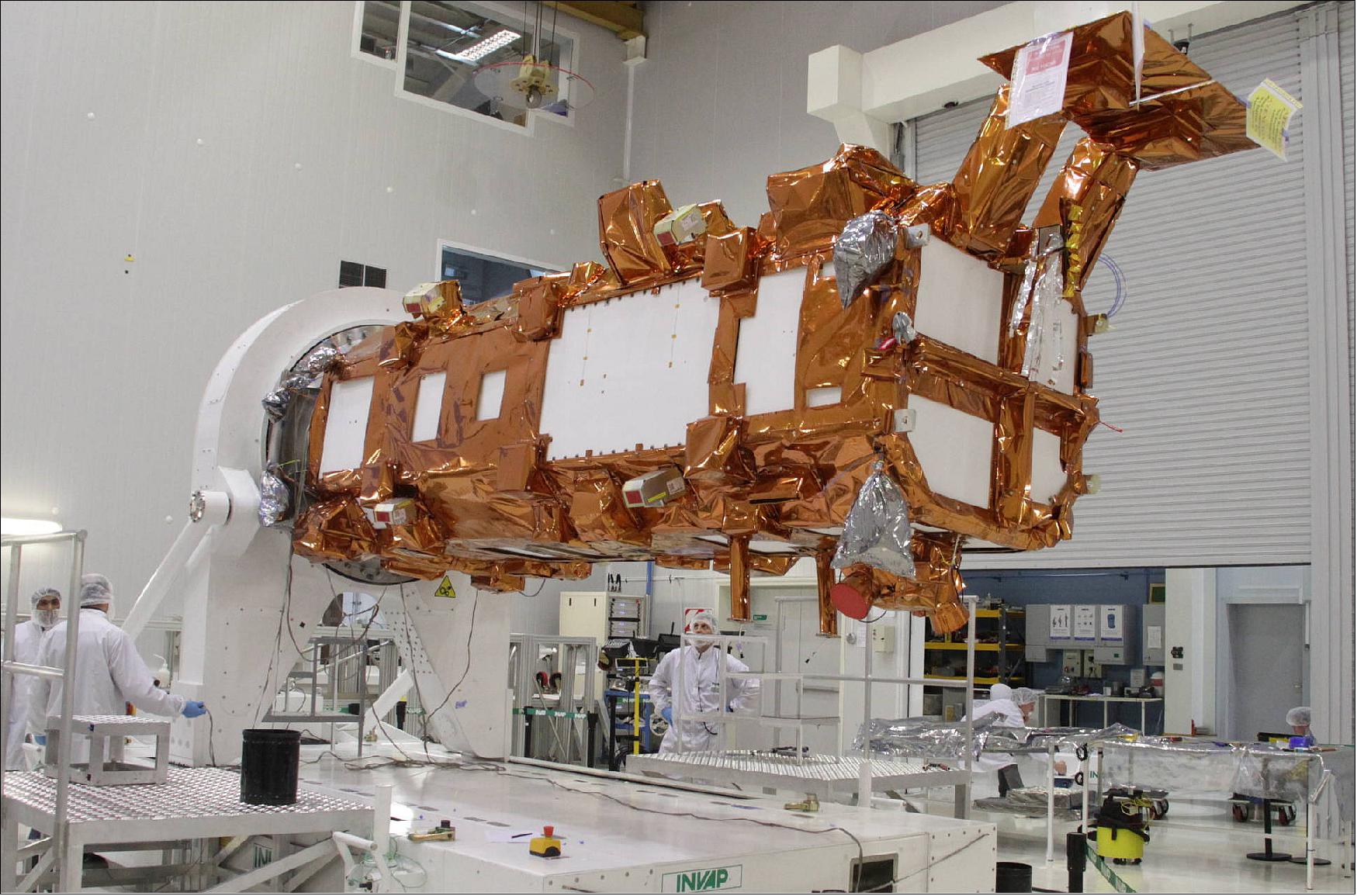
Launch
The SAOCOM-1A satellite was launched on 8 October 2018 (02.21 UTC) on a SpaceX Falcon-9 vehicle from VAFB, CA. Following stage separation, Falcon-9's first stage returned to land at SpaceX's Landing Zone 4 (LZ-4) at Vandenberg Air Force Base. This was SpaceX's first land landing on the West Coast. 10)
The launch of SAOCOM-1B is scheduled for 2019. — In April 2009, CONAE signed a contract with the launch service provider SpaceX (Space Exploration Technologies Corp.) of Hawthorne, CA, USA, the launch site is VAFB, SLC-4E (use of Falcon-9 1.2 launch vehicle). 11)
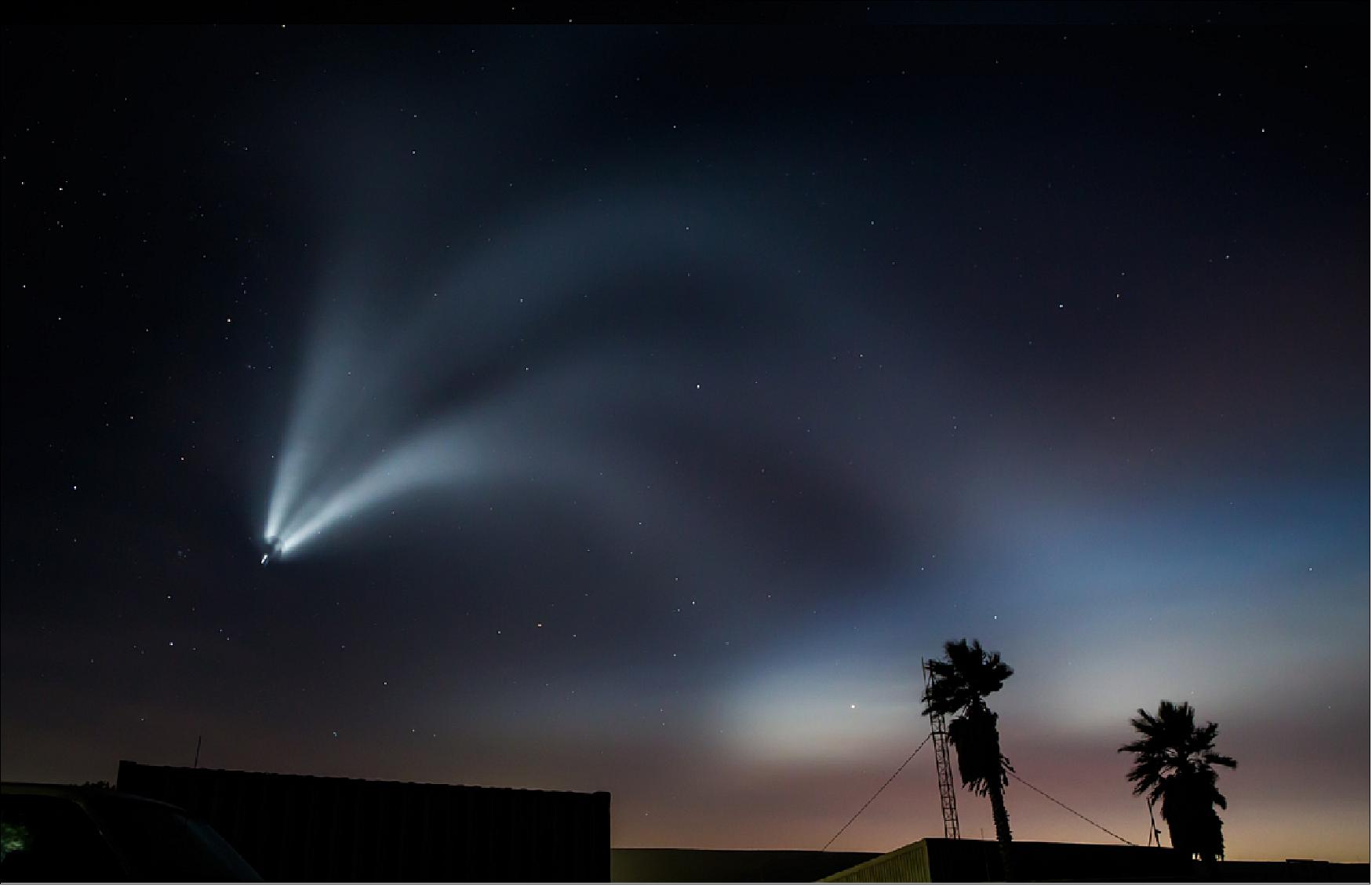
- An Earth observation satellite, SAOCOM-1A will provide welcome new data on our planet, stimulating projects to monitor the planet's forests, map soil moisture and measure surface deformation and motion from space, in the context of natural and anthropogenic disasters.
- With teams of experts at its ESOC operations center in Darmstadt, Germany, ESA is proud to be supporting CONAE with this important new endeavor.
- Moments after launch, ESA's flight dynamics specialists provided critical information to ground stations so they could track SAOCOM-1A, and soon after made their first 'orbit determination' — a vital step toward being able to communicate with the satellite. The flight dynamics team will continue calculating the satellite's orbit in the following weeks (Ref. 12).
Orbit: Sun-synchronous near-circular orbit (frozen dawn/dusk orbit), altitude = 619.6 km, inclination = 97.86º, period = 97.1 minutes, repeat cycle of 16 days (8 days for the constellation), LTAN (Local Time on Ascending Node) at 6:00 hours.
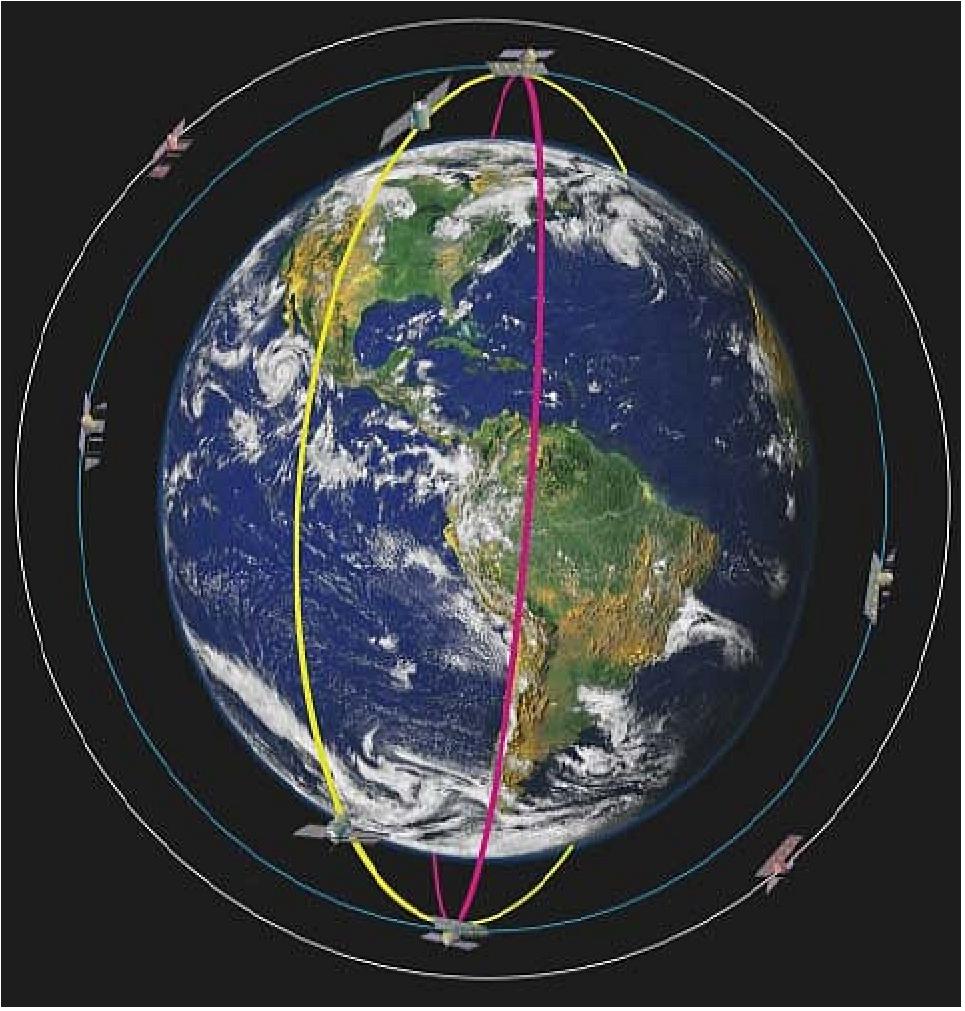
The same repeat cycles (16 days) of the COSMO-SkyMed and the SAOCOM constellations allows both projects to establish a common planning cycle and fixed operational chronologies for both constellations, to define meaningful programming requests, schedule image acquisitions, receive the download data from the satellites, and then process and correlate the relevant SAR imagery. 13)
The nominal SAR looking direction is to the right and the full SAR access range covers ten swaths in quad-pol (QP) mode and nine swaths in dual-pol mode. The SAR will be able to operate in stripmap imaging mode (the baseline for bistatic operations described later), with a swath width larger than of 40 km, as well as in TOPSAR (Terrain Observation with Progressive Scans SAR) mode. The SAR antenna radiating area approximate dimensions are 10 m by 3.5 m. The total mass of the SAOCOM-1 satellites is approximately 3 tons.
The SAOCOM-1B spacecraft of CONAE was launched on 30 August 2020 (23:19 UTC) on a Falcon-9 vehicle of SpaceX from SLC-40 at the Cape Canaveral Air Force Station, FL. The SAOCOM-1B satellite has a mass of 3050 kg and is identical to SAOCOM-1A. 14)
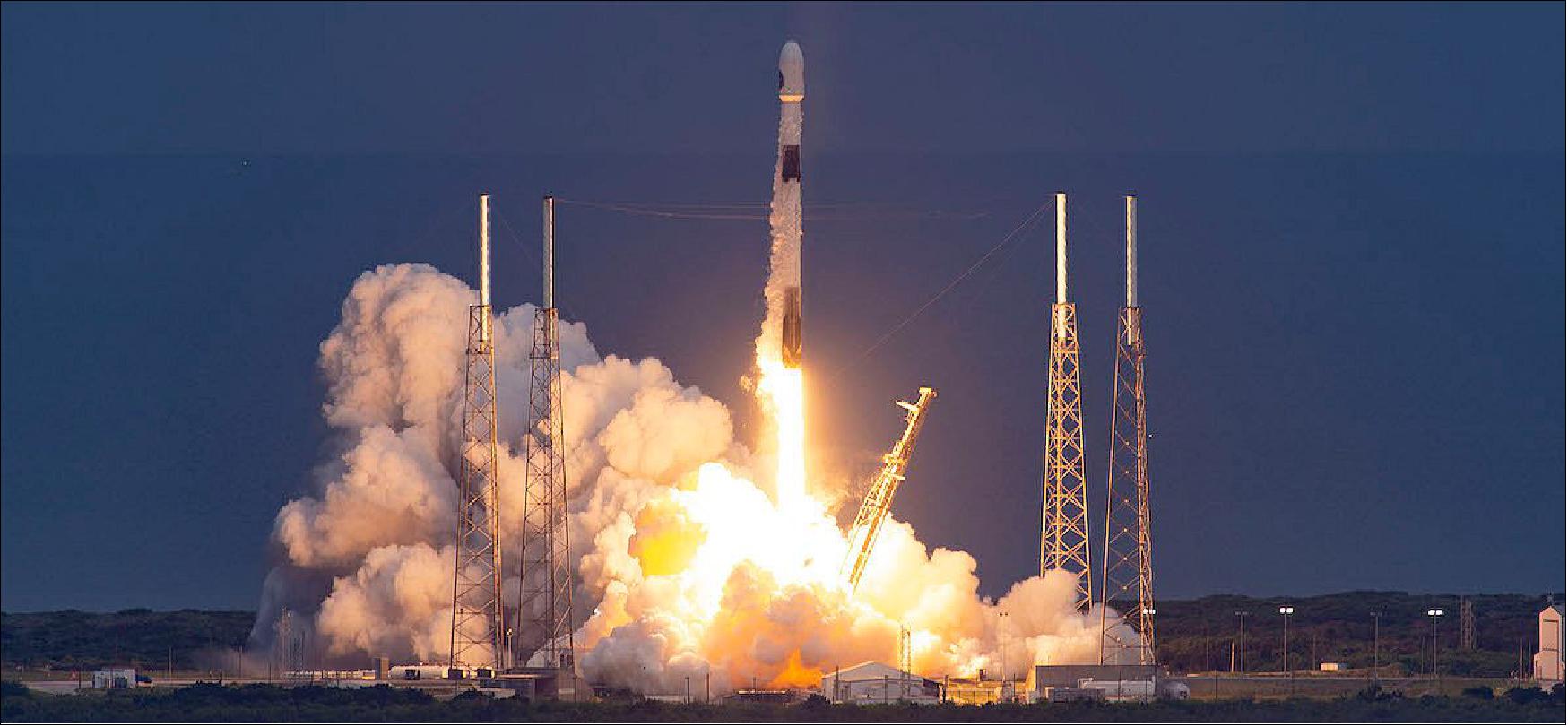
Vaulting away from Cape Canaveral on an unusual southerly trajectory, a Falcon 9 rocket dodged stormy weather and successfully placed an Argentine radar observation satellite into an orbit over Earth's poles Sunday on SpaceX's 100th launch.
Instead of launching toward the northeast or east, the Falcon 9 darted through a cloudy sky and arced to the south-southeast from Florida's Space Coast, then made a right turn to fly along the east coast of Florida over Fort Lauderdale and Miami on the way to a polar orbit.
The launch Sunday was the first from Cape Canaveral to fly on a southerly track since 1969. Since then, most U.S. launches into polar orbit have departed from Vandenberg Air Force Base in California, which has an open range over the Pacific Ocean that does not require rockets to make an in-flight turn, or "dogleg" maneuver, to avoid flying over land.
The nine Merlin engines on the Falcon 9's first stage shut down about two-and-a-half minutes after launch, then the booster — reused from three previous missions — separated and flipped around to begin thrusting back toward Cape Canaveral.
After firing engines to slow down, the booster extended landing legs and returned to Landing Zone 1 on Cape Canaveral Air Force Station about eight minutes into the mission, touching down as a powerful sonic boom rippled through an atmosphere thick with humidity.
It was the 18th time SpaceX has landed a Falcon 9 booster at Cape Canaveral since 2015, and the 59th successful recovery of a Falcon 9 first stage overall, including landings on SpaceX's ocean-going drone ships.
The Argentine-built satellite, equipped with a sophisticated radar imaging instrument, separated from the Falcon 9's upper stage about 14 minutes into the mission. Two smaller rideshare payloads — named GNOMES-1 and Tyvak 0172 — deployed from the Falcon 9 about 45 minutes later.
Orbit: Sun-synchronous near-circular orbit (frozen dawn/dusk orbit), altitude = 619.6 km, inclination = 97.86º, period = 97.1 minutes, repeat cycle of 16 days (8 days for the constellation), LTAN (Local Time on Ascending Node) at 6:00 hours.
Passenger Payloads
- GNOMES-1: A radio occultation microsatellite for PlanetiQ (of Golden CO, USA) was launched with SAOCOM-1B. The GNOMES (GNSS Navigation and Occultation Measurement Satellite) with a mass of ~ 30 kg is the first of a planned fleet of around 20 small microsatellites being developed by PlanetiQ to collect radio occultation data by measuring the effects of the atmosphere on signals broadcast by GPS, GLONASS, Galileo and BeiDou navigation satellites. The information can yield data on atmospheric conditions useful in weather forecasts.
- Tyvak 0172 is a small spacecraft built by Tyvak Nanosatellite Systems. Details about its mission have not been disclosed by SpaceX or Tyvak.
• March 24, 2020: Concerns about the coronavirus pandemic have prompted officials to postpone the planned March 30 launch of Argentina's SAOCOM 1B radar observation satellite from Cape Canaveral aboard a SpaceX Falcon 9 rocket, officials said Tuesday. 15)
- Travel restrictions imposed by coronavirus to slow the spread of the COVID-19 viral disease, and restrictions on non-essential work, have hindered space activity around the world. CONAE, Argentina's space agency, said the launch of the country's SAOCOM 1B Earth-imaging spacecraft will be postponed.
• July 6, 2020: A team of 18 Argentine engineers is quarantining in Florida this week after arriving from Buenos Aires, observing coronavirus health restrictions before beginning operations at Cape Canaveral next week to ready Argentina's second radar Earth observation satellite for liftoff as soon as July 25 on a SpaceX Falcon 9 rocket. 16)

- The SAOCOM-1B engineers who traveled to Florida tested negative for the COVID-19 virus before departing Argentina. They will be tested for the virus again before they are permitted to enter SpaceX facilities at Cape Canaveral, according to CONAE.
- The engineers will begin tasks Monday, July 13, to ready the 3,000 kg SAOCOM-1B spacecraft for launch. The team will verify the health of the satellite after coming out of three months in storage, then encapsulate the spacecraft inside the payload fairing of its Falcon 9 launcher.
- Argentine officials said the launch from pad 40 at Cape Canaveral Air Force Station is scheduled between July 25 and July 30. The launch time each day is set for approximately 7:19 p.m. EDT (23:19 GMT).
Mission Status
• September 26, 2019: The SAOCOM-1A mission was presented at the ITU International Satellite Symposium 2019 in Bariloche, Argentina. 17) — Only viewgraphs are shown with virtually no text. Obviously, the SAOCOM-1A spacecraft is operational and providing imagery. The SAOCOM L-band system operates jointly with the Italian COSMO-SkyMed constellation in X-band for better coverage of emergency events. This cooperation is referred to as SIASGE (Sistema Italo Argentino de Satélites para la Gestion de Emergencias).
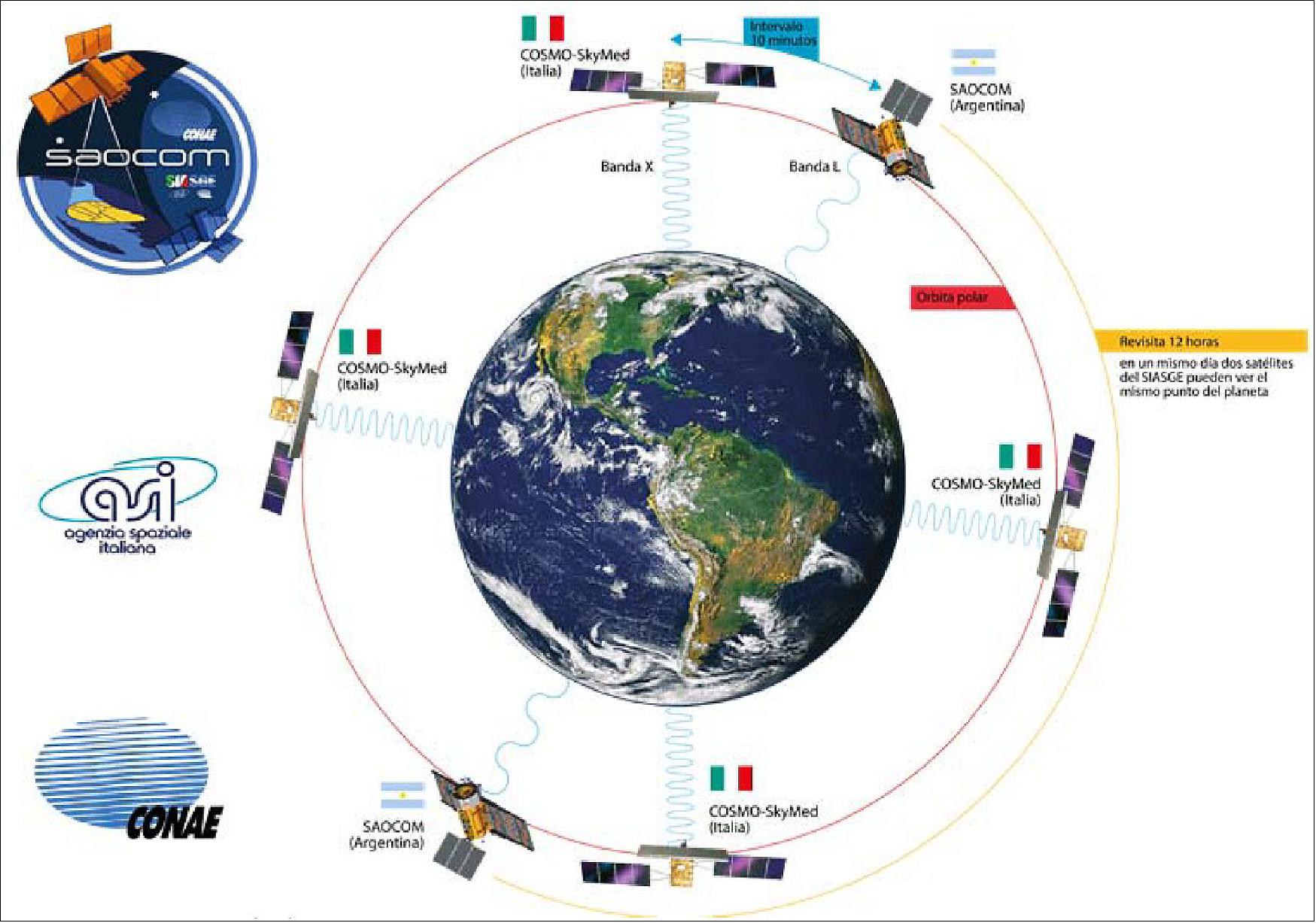
SAOCOM System Operation
- Full operation from Mission Operation Center in CETT (Centro Espacial Teófilo Tabanera), CONAE –Cordoba.
- 225 acquisitions per day per Satellite –450 minutes per day
- Right and left looking
- Routine System Ground Stations
a) ETC (Estación Terrena de Córdoba), Argentina: X- & S-bands
b) ETT (Estación Terrena de Tierra del Fuego), Argentina: X- & S-bands
c) SGS (Svalbard Ground Station), Norway: X- & S-bands.
d) IMT, Matera, Italy, X-band.
• October 8, 2018: After the separation of the launcher, the initial sequence of activities of the new Argentine satellite SAOCOM-1A began. This involved deploying the solar panels and making the release of the radar antenna, whose wings were attached to the main body of the satellite to give rigidity to the whole, avoiding the impact of strong vibrations due to takeoff. 18)
- The first contact of SAOCOM-1A on a portable earth station in Tahiti allowed verifying that these automatic activities had been executed successfully, as planned. The following passes through the different stations of the terrestrial network were used to carry out the necessary measurements for the determination of the orbit by two methods, on the one hand the measurements with GPS (even without validation) and on the other hand through the use of "ranging" signals (this is measurement of the transit time of the S-band signal) and its subsequent processing by the flight dynamics service of the ESA.
- On October 8, from early morning until 6:00 pm, the two wings of the radar antenna were deployed, first the wing + X and then the wing -X as they are called. Each panel was deployed one by one as the spacecraft passed over a station, until completing the three panels of each wing. This very delicate deployment operation began to be carried out from the Mission Control Center through the Cordoba Earth Station and ended 12 hours later from the Tierra del Fuego Earth Station, all commanded from the Mission Control Center in Cordoba.
- On October 9, the satellite was maneuvered so that its orientation was fixed as it will remain throughout its useful life and will be maintained by the attitude control system.
- The SAOCOM 1A already has its solar panels working, producing the energy that is stored in the battery of the satellite platform, and the radar antenna of 35 m2 is fully deployed and pointing into the right direction of the flight path. Each system enabled so far operates within the expected performance or better.
Sensor Complement
SAOCOM-SAR (SAOCOM-Synthetic Aperture Radar)
SAOCOM-SAR is an L-band polarimetric SAR instrument, the prime payload of the mission with the following objectives: 19) 20)
• To provide all weather, day/night polarimetric L-band SAR observations
• To satisfy most of the applications considered in the Argentinean National Space Program, involving studies on agriculture, fishery, forestry, weather, hydrology, oceanography, emergencies, natural resources of land and sea, urban areas, cartography, geology, mining, soil exploitation, archeology and health. Emergencies, such as floods, droughts, desertification, landslides, oil slicks in land and ocean, fires, seismology, earthquake activity and volcanism, are mainly considered.
• To develop soil moisture map products for giving support to agricultural, hydrological and health applications, and emergencies in general
• To develop SAR interferometric techniques for collaborating with the development of different applications.
Parameter | Value | Parameter | Value |
Center frequency | 1275 MHz (L-band) | Antenna looking angle | right (nominal) |
|
| Incidence angles | 18-50º |
Maximum bandwidth | =50 MHz | Data quantization | 4 bit Block Adaptive Quantization |
Transmit peak power | 6.7 kW | Duty cycle | 15% (about 15 minutes per orbit, depending on selected datatakes modes datarate and available ground stations) |
Operational modes | Stripmap | Stripmap high resolution | 10 m x 10 m (pixel) |
Stripmap swath width | > 65 km (each beam) | TopSAR narrow swath | 150 or 176 km (SP/DP) |
Signal transmission | HH or VV polarization | Signal | HH or VV (single pol.) |
NESZ (Noise Equivalent Sigma Zero) | < -28 dB single and dual pol modes | TopSAR narrow mode | 30 m x 30 m (SP & DP): |
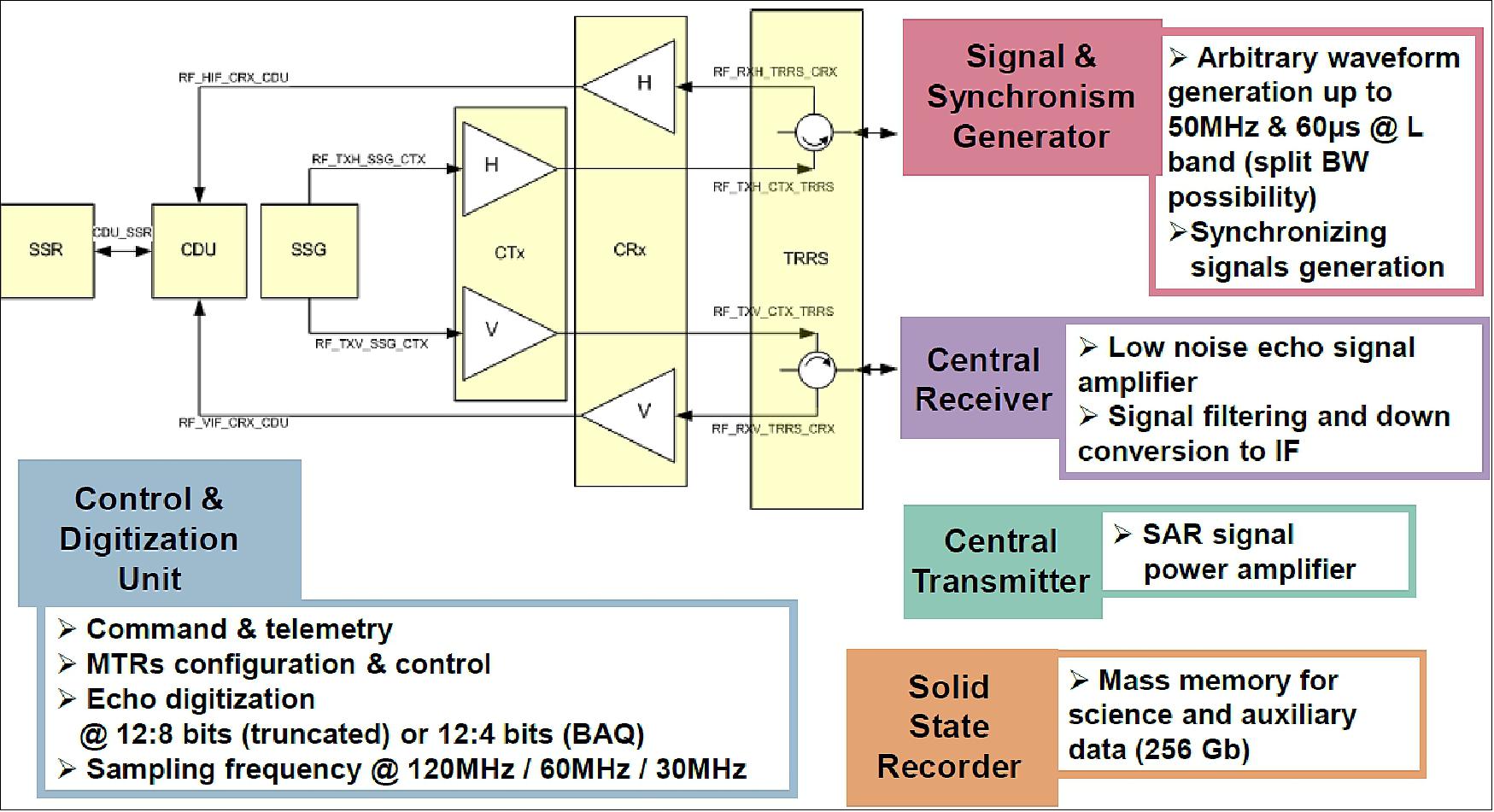
Acquisition | Polarization mode | Swath | Spatial | Incidence angle |
Stripmap | SP: HH or HV or VH or VV | > 40 km | < 10 m | 21º - 50º |
TopSAR narrow | SP: HH or HV or VH or VV | > 150 km | < 30 m | 25º - 45º |
TopSAR wide | SP: HH or HV or VH or VV | > 350 km | < 50 m | 25º - 45º |
Legend to Table 2: SP = Single Polarization; DP = Dual Polarization; QP = Quad Polarization
Ground Segment
The ground segment, includes all the activities from spacecraft monitoring/control to data product generation and distribution.
• The spacecraft operation is being done by the CONAE Control Center at Cordoba, Argentina (also location of the Cordoba ground station). All data processing, archiving and distribution is being provided by the MOC (Mission Operations Center) facility at Cordoba.
• The Matera ground station of ASI, Italy will be available for L-band SAR imagery downlinks.
References
1) Laura Frulla, Jorge Milovich, Gladys Rodriguez Ortega, Marc Thibeault, "CONAE's SAR Missions Overview," International GEO Workshop on Synthetic Aperture Radar (SAR) to Support Agricultural Monitoring, Nov. 2-4, 2009, Kananaskis, Alberta, Canada
2) A. E. Giraldez, "SAOCOM-1 Argentina L-band SAR Mission Overview," Proceedings of the 2nd Workshop on Coastal and Marine Applications of SAR (CMASAR), Sept. 8-12, 2003, Svalbard, Norway, URL: http://earth.esa.int/workshops/cmasar_2003/papers/E27gira.pdf
3) L. Frulla, "L-band SAR SAOCOM Mission and SIASGE System. Some applications," Proceedings of POLinSAR 2003, ESA/ESRIN, Frascati, Italy, Jan. 14-16, 2003
4) http://www.earthobservations.org/documents/committees/uic/200708_5thUIC/Platzcek-CONAE.pdf
5) C. Barbier, "Argentina - Belgium Cooperation on the SAOCOM Mission
6) Laura Frulla, J. Medina, J. Milovich, G. R. Ortega, Marc Thibeault, "SAOCOM Mission Overview," 2011 CEOS SAR Calibration and Validation Workshop Fairbanks, Alaska, USA, Nov. 7-9, 2011, URL: http://media.asf.alaska.edu/asfmainsite/documents
/2011-ceos-workshop/SAOCOM-mission%20overview,%20J.Medina.pdf
7) Michael Baylor, "SAOCOM 1A ships to Vandenberg as Falcon 9 prepares for the first west coast RTLS," NASA Spaceflight.com, 1 August 2018, URL: https://www.nasaspaceflight.com
/2018/08/saocom-1a-ships-vandenberg-falcon-9-first-west-coast-rtls/
8) "Argentina's SAOCOM 1-A Satellite Continues Launch Preparations," Satnews Daily, 29 July 2018, URL: http://www.satnews.com/story.php?number=1716361527&menu=1
9) "The assemblage of the SAOCOM 1A satellite was concluded," INVAP, 2 January 2018, URL: http://www.invap.com.ar/en/invap-2/newsroom
/news-invap/1580-the-assemblage-of-the-saocom-1a-satellite-was-concluded.html
10) "SpaceX's NightLight Launches SAOCOM 1A Satellite and a Successful Return of Falcon 9," Satnews Daily, 8 October 2018, URL: http://www.satnews.com/story.php?number=1392175371
11) "SpaceX signs Argentina's Space Agency for two Falcon 9 Launches," 16 April , 2009, URL: https://spaceref.com/press-release/spacex-signs-argentinas-space-agency-for-two-falcon-9-launches/
12) "Argentina ascends," ESA, Operations image of the week, 10 October 2018, URL: http://m.esa.int/spaceinimages/Images/2018/10/Argentina_ascends
13) Giuseppe Francesco De Luca, Giovanni Rum, Francesco Caltagirone, Pasquale Maurizio De Carlo, Graziano Marano, Giuseppe Angino, Matteo Piemontese, "COSMO-SkyMed Interoperability, Expandability and Multi-Sensor Capabilities: The Keys for Full Multi-Mission Spectrum Operations," Proceedings of NATO Research and Technology Organization RTO-MP-SCI-150, Paper 3., 2005, Neuilly-sur-Seine, France URL: http://www.dtic.mil/cgi-bin/GetTRDoc?AD=ADA469910&Location=U2&doc=GetTRDoc.pdf
14) Stephen Clark, "SpaceX launches first polar orbit mission from Florida in decades," Spaceflight Now, 31 August 2020, URL: https://spaceflightnow.com/2020/08/31/spacex-launches-first-polar-orbit-mission-from-florida-in-decades/
15) Stephen Clark, "Coronavirus concerns force postponement of SpaceX launch with Argentine satellite," 24 March 2020, URL: https://spaceflightnow.com/2020/03/24/
coronavirus-concerns-force-postponement-of-spacex-launch-with-argentine-satellite/
16) Stephen Clark, "Argentine team returns to Florida to prep radar satellite for late July launch," Spaceflight Now, 6 July 2020, URL: https://spaceflightnow.com/2020/07/06/
argentine-team-returns-to-florida-to-prep-radar-satellite-for-late-july-launch/
17) Josefina Péres, Nicolas Renolfi, "SAOCOM Mission- Earth Observation for Scientific and Commercial Applications,"ITU International Satellite Symposium, 21-26 September 2019Bariloche, Argentina, URL: https://www.itu.int/en/ITU-R/space/workshops/2019-SatSymp/Presentations/206%20%20Passive%20Bands%20-%20SAOCOM%20-CONAE%20--Invap%20Argentina.pdf
18) "Successful launch of the SAOCOM 1A Satellite — The first steps of SAOCOM 1A in Space," CONAE, 10 October 2018, URL: https://www.argentina.gob.ar/noticias/exitoso-lanzamiento-del-satelite-saocom-1a
19) D. Dadamia, M. Thibeault, "Towards obtaining operative soil moisture products using SAR data from the SAOCOM mission," URL: http://smap.jpl.nasa.gov/files/smap2/apps_p2_Dadamia.pdf
20) Davide Giudici, Andrea Monti Guarnieri, Juan Pablo Cuesta Gonzalez, "Pre-Flight SAOCOM-1A SAR Performance Assessment by Outdoor Campaign," Remote Sensing, 2017, Vol.9, No 7, URL of abstract, https://doi.org/10.3390/rs9070729 URL: http://www.mdpi.com/2072-4292/9/7/729/htm
21) Laura Frulla, J. Medina, J. Milovich, G. R. Ortega, Marc Thibeault, "SAOCom Misson Overview," 2011 CEOS SAR Calibration and Validation Workshop Fairbanks, Alaska, USA, 7-9 November 2011, URL: http://sarcv.ceos.org/site_media/media/documents/SAOCOM-mission_overview_J.Medina_1.pdf
The information compiled and edited in this article was provided by Herbert J. Kramer from his documentation of: "Observation of the Earth and Its Environment: Survey of Missions and Sensors" (Springer Verlag) as well as many other sources after the publication of the 4th edition in 2002. - Comments and corrections to this article are always welcome for further updates (eoportal@symbios.space).
Spacecraft Launch Mission Status Sensor Complement Ground Segment References Back to top